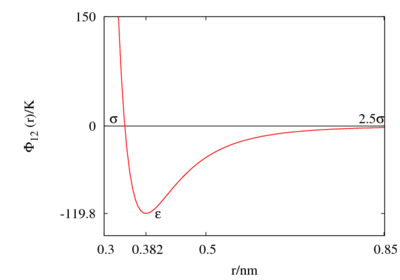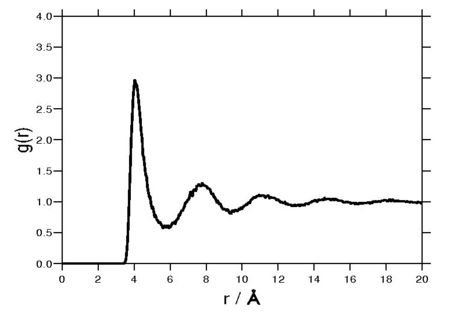Lennard-Jones model: Difference between revisions
Carl McBride (talk | contribs) m (Added a little to the introduction.) |
Carl McBride (talk | contribs) m (Added internl link to the Mie potential) |
||
| Line 75: | Line 75: | ||
*[[Lennard-Jones disks]] | *[[Lennard-Jones disks]] | ||
*[[9-3 Lennard-Jones potential]] | *[[9-3 Lennard-Jones potential]] | ||
*[[Mie potential]] | |||
==References== | ==References== | ||
#[http://dx.doi.org/10.1088/0959-5309/43/5/301 J. E. Lennard-Jones, "Cohesion", Proceedings of the Physical Society, '''43''' pp. 461-482 (1931)] | #[http://dx.doi.org/10.1088/0959-5309/43/5/301 J. E. Lennard-Jones, "Cohesion", Proceedings of the Physical Society, '''43''' pp. 461-482 (1931)] | ||
Revision as of 12:56, 21 April 2008
The Lennard-Jones intermolecular pair potential was developed by Sir John Edward Lennard-Jones in 1931 (Ref. 1). The Lennard-Jones model consists of two 'parts'; a steep repulsive term, and smoother attractive term, representing the London dispersion forces.
Functional form
The Lennard-Jones potential is given by:
where:
- is the intermolecular pair potential between two particles at a distance r;
- is the diameter (length), i.e. the value of at ;
- : well depth (energy)
Reduced units:
- Density, , where (number of particles divided by the volume .)
- Temperature; , where is the absolute temperature and is the Boltzmann constant
The following is a plot of the Lennard-Jones model for the parameters 120 K and 0.34 nm. See also argon for appropriate parameter sets.

This figure was produced using gnuplot with the command:
plot (4*120*((0.34/x)**12-(0.34/x)**6))
Special points
- Minimum value of at ;
Critical point
The location of the critical point is (Caillol (Ref. 2))
at a reduced density of
- .
Vliegenthart and Lekkerkerker (Ref. 4) have suggested that the critical point is related to the second virial coefficient via the expression
Triple point
The location of the triple point as found by Mastny and de Pablo (Ref. 3) is
Approximations in simulation: truncation and shifting
The Lennard-Jones model is often used with a cutoff radius of . See Mastny and de Pablo (Ref. 3) for an analysis of the effect of this cutoff on the melting line.
m-n Lennard-Jones potential
It is relatively common to encounter potential functions given by:
with and being positive integers and . is chosen such that the minimum value of being . Such forms are usually referred to as m-n Lennard-Jones Potential. For example, the 9-3 Lennard-Jones interaction potential is often used to model the interaction between the atoms/molecules of a fluid and a continuous solid wall. On the '9-3 Lennard-Jones potential' page a justification of this use is presented.
Radial distribution function
The following plot is of a typical radial distribution function for the monatomic Lennard-Jones liquid (here with and kcal/mol at a temperature of 111.06K:

Equation of state
- Main article: Lennard-Jones equation of state
Virial coefficients
- Main article: Lennard-Jones model: virial coefficients
Phase diagram
- Main article: Phase diagram of the Lennard-Jones model
Related models
References
- J. E. Lennard-Jones, "Cohesion", Proceedings of the Physical Society, 43 pp. 461-482 (1931)
- J. M. Caillol " Critical-point of the Lennard-Jones fluid: A finite-size scaling study", Journal of Chemical Physics 109 pp. 4885-4893 (1998)
- Ethan A. Mastny and Juan J. de Pablo "Melting line of the Lennard-Jones system, infinite size, and full potential", Journal of Chemical Physics 127 104504 (2007)
- G. A. Vliegenthart and H. N. W. Lekkerkerker "Predicting the gas–liquid critical point from the second virial coefficient", Journal of Chemical Physics 112 pp. 5364-5369 (2000)
![{\displaystyle \Phi (r)=4\epsilon \left[\left({\frac {\sigma }{r}}\right)^{12}-\left({\frac {\sigma }{r}}\right)^{6}\right]}](https://wikimedia.org/api/rest_v1/media/math/render/svg/b0ecd4ec335b5149b5f30ba2d02a6049d0407207)






















![{\displaystyle \Phi (r)=c_{m,n}\epsilon \left[\left({\frac {\sigma }{r}}\right)^{m}-\left({\frac {\sigma }{r}}\right)^{n}\right].}](https://wikimedia.org/api/rest_v1/media/math/render/svg/58317a77137d2a636f30e2a4a48c2ba87b516598)






